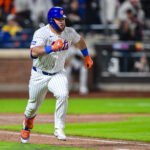
The Mets of the late 90s are remembered for the acquisition of Mike Piazza in May 1998, Robin Ventura‘s “Grand Slam Single,” and the postseason run of 1999. But the foundation for a winning culture began during a season in which they had low expectations and little experience with success.
Bobby Valentine‘s first full year as Mets manager may have been his most impressive job. Promoted after leading the Triple-A Norfolk Tides and the firing of Dallas Green in August 1996, the Mets were a club that was worse than the sum of its parts. Three members of the lineup—Todd Hundley, Bernard Gilkey, and Lance Johnson—set franchise hitting records. And yet those individual efforts didn’t lead to positive outcomes in the standings.
New York wound up 20 games under .500, with Valentine riding out the sinking ship to a 12-19 record. To shore up the lineup, the most significant offseason upgrade came in a trade that sent pitcher Robert Person to the Blue Jays in exchange for veteran first baseman John Olerud.
He’d spent eight productive seasons in Toronto, winning two World Series titles, three Gold Gloves, and a batting title. His disposition was better suited for Canada than Queens, it seemed. But he quickly found the National League to his liking. Better utilizing his fluid swing so that he could spray balls to all fields, Olerud batted 20 points higher than in ’96 with the Blue Jays, maintained terrific fielding at first base, and established team records in just three seasons. His 102 RBIs, 22 homers, and 34 doubles were the most since his stellar 1993. And on September 11, he became the seventh Met to hit for the cycle.
Edgardo Alfonzo truly began to enter Mets lore in ’97, establishing himself as one of the greatest and most beloved players ever. Playing the bulk of his games at third base, Fonzie accumulated the highest bWAR (6.2), slashed .315/.391/.432, and began a string of eight straight years with at least 20 doubles.
Hundley, meanwhile, followed up on his historic ’96 in which his 41 homers set a franchise mark and were the most in one year by a catcher. His 30 blasts led the club, as did 86 RBIs—and he was one of five Mets to drive in at least 70 (joining Alfonzo, Olerud, Gilkey, and Butch Huskey).
The Mets had just one All-Star named to the NL team. It wasn’t Olerud, nor Alfonzo, and not Hundley. The lone blue-and-orange representative? Starting pitcher Bobby Jones, who went seven innings or more in 13 of his 18 first-half starts to post a 3.08 ERA.
Jones’ rotation-mate, Rick Reed, a fellow right-hander without a flame-throwing pitch in his arsenal, was only a big-leaguer in 1995 because of the strike that ruined the ’94 season and bled into the following spring training. It was a devastating blow for the sport. Yet it was the best thing to happen for Reed. MLB threatened to use replacement players, of which Reed was one. It never came to pass in the regular season, but Reed hung on. And in his first year with New York, he led all starters with a 2.89 ERA and a 1.042 WHIP.
Reed posted 11 quality starts over the final three months of the season, as Valentine’s group—who went 18-9 in May to jump beyond respectability—enjoyed winning records in June and July to emerge as one of the surprise stories in baseball.
After a tough 15-inning loss to the Montreal Expos at home on September 12, their hopes for the lone NL Wild Card spot appeared faint. More so when they were down 6-0 in the ninth less than 24 hours later. A single scored two, and another hit loaded the bases for left-handed swinging Carl Everett. On a 3-2 pitch from Ugueth Urbina, Everett connected on a changeup and blasted it below the right-center field scoreboard.
The improbabilities continued in the bottom of the 11th with two on. Bernard Gilkey, out of the starting lineup because of a sprained ankle, summoned up the power
The last-gasp effort against Montreal had Mets fans thinking about playoffs. It had been seven years since they could even entertain the idea of a postseason this late. With 15 games left, they were five back of the Marlins.
However, a five-game skid that followed truly ended New York’s hopes. The Mets took two of three in the final series to finish with 88 victories, the most by the franchise since the start of the decade. The Marlins not only took that playoff berth but took it all the way to a World Series title.
The 1997 season gets largely forgotten. By wildly exceeding expectations and maintaining more than relevance into September, it was the year in which the Mets were finally fun again.















